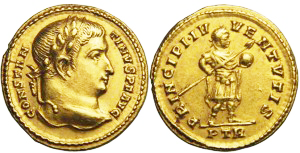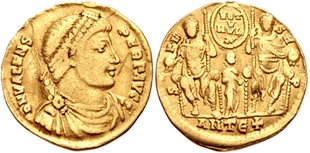
This page created 26 July 2014, and last modified: 30 October (Frankfurt fragment image added)

One of the auxilia palatina units in the Magister Peditum's infantry roster is named the Felices Valentinianenses; it is assigned to the command of the Comes Illyricum under the name Valentinianenses felices. Its shield pattern in various manuscripts is as shown below:

The pattern features a red rim, a yellow main ground, and a robed figured in orange (red in B, maroon in M, and olive in W) holding a staff in the right hand and holding aloft a globe in the left; the globe is not visible in W, B, and Ff. Indeed, the pattern in Ff is not only very badly damaged (due to having been used as a book cover), but has actually been swapped with the pattern of the next unit in the roster; the Mattiaci iuniores Gallicani, hence the label reading "Mattiaci (?)", as the lables have not been swapped in the same manner.
Although there is evidence that many labels attached to the shield patterns illustrating the western auxilia platina have been shifted from their proper places, it is not clear that this has happened to this unit; it may well be labelled with the correct shield pattern (except as noted above in the Frankfurt fragment).
The name Felices is a very common name for units in the Notitia, with over twenty units bearing the name; it means "fortunate, lucky", as well as "fruitful, fertile, productive". The first of these meanings is probably more likely for a military unit.
The name Valentinianenses refers to either emperor Valentinian I, II, or III; who reigned 364-375, 375-392, and 419-455; the last of these would appear to be too late a unit positioned as far up the roster as it is, leaving Valentinian I or his son Valentinian II as candidates. Given the shield pattern shows a personage - whether divine or "merely" imperial, and that none of the nearby other units above and below the Felices Valentinianenses in the Magister Peditum's roster have names that allude to a personage (see below), it is tempting to conclude that the pattern shown here correctly matches its label. Since Valentinian I and II were both firm Christians, this would appear to rule out the image representing a god, so the person is presumably one of these two emperors. Representations of emperors holding a globe are common in Imperial Roman art; the globe is often surmounted by a winged Victory; in the case of 4th century emperors depicted on coins, the right hand often grasps a labarum chi-rho standard. However, not all do; the coin of Constantine I below shows the emperor with a plain globe and a spear (this coin was struck in 310, before Constantine became a Christian, so making a labarum an impossibility, but later coins show his son Crispus in an identical manner).

Photo from terrasiniancientcoins.com
Similarly, the coin below from 369 has two plain globse, in this case, a matched set held by the emperors Valens and Valentinian I; they each also hold a long sceptre rather than a spear, and this may well be what is being depicted in the Felices Valentinianenses shield pattern.

Photo from www.edgarlowen.com
If the shield pattern does not show either Valentinian I or II, and thus not belong to the Felices Valentinianenses, then the closest candidate in the Magister Peditum's list with a correspondence between name and pattern is the Iovii iuniores Gallicani, in which case the personage would be Jupiter (Iovius). However, no other clear examples of divinities are shown in the Notitia - we only see "attributes" of divinities, such as winged Victories.

Return to the Notitia alphabetical unit list page.
Return to my Notitia index page.